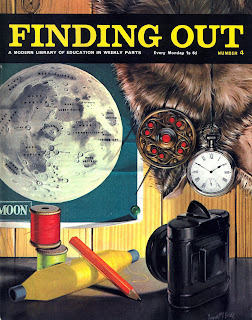A staple feature of growing up in the sixties, were the educational magazines available at newsagents, such as Treasure, Look and Learn and World of Wonder. I recently came across one I had been previously unaware of, which was published the same year I was born, in 1962 , on a weekly basis. It appears to have been quite successful and I picked up the first two volumes of ten issues each online. The main reason for buying them, was the glorious painted artwork on the covers, which turned out to be by an artist called Angus McBride.
McBride's covers are bright and exciting, with an almost photographic detail. the interior illustrations are by a variety of artists, mostly of a high standard and a mixture of colour and monochrome.
The satellite was a joint British and American project and was put into orbit by an american Thor-Delta rocket. Unfortunately, the american high altitude nuclear test, Starfish Prime damaged the satellite with its burst of radiation, deactivating the timer on board. The satellite eventually burned up in re-entry in 1976.
Some contemporary news articles from 1962 - note the mis-spelling of 'aerial' on the central article. the satellite was named after the Shakespearean character from 'The Tempest'.
A 2009 infographic from The Times newspaper, showing the state of the British Space industry to date.'Finding Out' magazine's other space related covers, a bleak martian landscape and a moon map indicate the content featured inside.








I got World of Wonder every week - I think it ran for about five years. Once it ended, and was incorporated in to Look and Learn, I read Look and Learn until that too folded. I did have a few issues of Finding Out, but only a handful. I think it might have been an encyclopedia issued in weekly parts ? Fairly heavy paper as I recall.
ReplyDeleteYes Paul, very heavy stock and a binder to put them in. I got Tell Me Why for years, untill that was eaten by World of Wonder. I was gutted when it went to L& L as I found that quite dry in comparison. Bill
DeleteThis is interesting. https://www.lookandlearn.com/
ReplyDeleteWith a bit of effort you might find the McCall Nuclear Ferry article in there! Bill
Lovely post Bill, those were indeed work of art each and every issue. It was a different time when subscriptions to magazines and comics was a huge pleasure for kids like us. I adored getting my own, my favourite being Look-In. Although not a factual comic I loved its arrival on the doormat. Since re-discovering these factual magazines, largely through you, I've picked up quite a few Look and Learns and several others. I guess the How and Why softback books were the next step from these fabulous comics.
ReplyDeleteI used to get Ranger magazine until it was folded into Look and Learn.
ReplyDeleteI was not familiar with Angus McBride's work, mostly remembering Don Lawrence, Oliver Frey, Roy Cross and Wilf Hardy, but I see Angus also worked for Osprey Publications.
https://en.m.wikipedia.org/wiki/Angus_McBride
I know McBride from the Middle Earth role-playing games. Beautiful work. He's on my list of artists for my blog series.
ReplyDeleteIve never seen those Tolkien illustrations, beautiful. Puts me in mind of the Brothers Hildebrandt paintings Bill
ReplyDeleteThose still life covers are strange aren't they. A cowboy boot on an alien landscape. And a magical brooch -Celtic? - next to a bike lamp. Captivating covers!
ReplyDelete